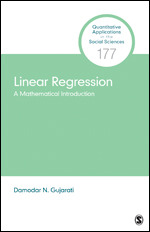List of Figures
Series Editor’s Introduction
Preface
About the Author
Acknowledgments
Chapter 1: The Linear Regression Model (LRM)
1.2 Meaning of “Linear” in Linear Regression
1.3 Estimation of the LRM: An Algebraic Approach
1.4 Goodness of Fit of a Regression Model: The Coefficient of Determination (R2)
1.5 R2 for Regression Through the Origin
1.6 An Example: The Determination of the Hourly Wages in the United States
Appendix 1A: Derivation of the Normal Equations
Chapter 2: The Classical Linear Regression Model (CLRM)
2.1 Assumptions of the CLRM
2.2 The Sampling or Probability Distributions of the OLS Estimators
2.3 Properties of OLS Estimators: The Gauss–Markov Theorem
2.4 Estimating Linear Functions of the OLS Parameters
2.5 Large-Sample Properties of OLS Estimators
Chapter 3: The Classical Normal Linear Regression Model: The Method of Maximum Likelihood (ML)
3.3 The Likelihood Function of the k-Variable Regression Model
3.4 Properties of the ML Method
Appendix 3A: Asymptotic Efficiency of the ML Estimators of the LRM
Chapter 4: Linear Regression Model: Distribution Theory and Hypothesis Testing
4.3 Procedure for Hypothesis Testing
4.4 The Determination of Hourly Wages in the United States
4.5 Testing Hypotheses About an Individual Regression Coefficient
4.6 Testing the Hypothesis That All the Regressors Collectively Have No Influence on the Regressand
4.7 Testing the Incremental Contribution of a Regressor
4.8 Confidence Interval for the Error Variance s 2
4.9 Large-Sample Tests of Hypotheses
Appendix 4A: Constrained Least Squares: OLS Estimation Under Linear Restrictions
Chapter 5: Generalized Least Squares (GLS): Extensions of the Classical Linear Regression Model
5.2 Estimation of B With a Nonscalar Covariance Matrix
5.3 Estimated Generalized Least Squares
5.4 Heteroscedasticity and Weighted Least Squares
5.5 White’s Heteroscedasticity-Consistent Standard Errors
Appendix 5A: ML Estimation of GLS
Chapter 6: Extensions of the Classical Linear Regression Model: The Case of Stochastic or Endogenous Regressors
6.2 X and u Are Distributed Independently
6.3 X and u Are Contemporaneously Uncorrelated
6.4 X and u Are Neither Independently Distributed Nor Contemporaneously Uncorrelated
6.5 The Case of k Regressors
6.6 What Is the Solution? The Method of Instrumental Variables (IVs)
6.7 Hypothesis Testing Under IV Estimation
6.8 Practical Problems in the Application of the IV Method
6.9 Regression Involving More Than One Endogenous Regressor
6.10 An Illustrative Example: Earnings and Educational Attainment of Youth in the United States
6.11 Regression Involving More Than One Endogenous Regressor
Appendix 6A: Properties of OLS When Random X and u Are Independently Distributed
Appendix 6B: Properties of OLS Estimators When Random X and u Are Contemporaneously Uncorrelated
Chapter 7: Selected Topics in Linear Regression
7.2 The Nature of Multicollinearity
7.3 Model Specification Errors
7.4 Qualitative or Dummy Regressors
Appendix 7A: Ridge Regression: A Solution to Perfect Collinearity
Appendix 7B: Specification Errors
Appendix A: Basics of Matrix Algebra
A.8 Finding the Inverse of a Square Matrix
A.9 Trace of a Square Matrix
A.10 Quadratic Forms and Definite Matrices
A.11 Eigenvalues and Eigenvectors
A.12 Vector and Matrix Differentiation
Appendix B: Essentials of Large-Sample Theory
B.3 The Order of Magnitude of a Sequence
B.4 The Order of Magnitude of a Stochastic Sequence
Appendix C: Small- and Large-Sample Properties of Estimators
C.1 Small-Sample Properties of Estimators
C.2 Large-Sample Properties of Estimators
Appendix D: Some Important Probability Distributions
D.1 The Normal Distribution and the Z Test
D.2 The Gamma Distribution
D.3 The Chi-Square (? 2) Distribution and the ? 2 Test
D.4 Student’s t Distribution
D.5 Fisher’s F Distribution
D.6 Relationships Among Probability Distributions
D.7 Uniform Distributions
D.8 Some Special Features of the Normal Distribution
Index

